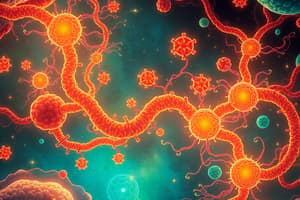Podcast
Questions and Answers
Where does glycolysis occur in the cell?
Where does glycolysis occur in the cell?
- Mitochondria
- Cytoplasm (correct)
- Endoplasmic Reticulum
- Nucleus
How many ATP molecules are produced during glycolysis?
How many ATP molecules are produced during glycolysis?
- 0
- 2 (correct)
- 8
- 4
What is the end product of glycolysis?
What is the end product of glycolysis?
- Fructose-1,6-bisphosphate
- Pyruvate (correct)
- Glyceraldehyde-3-phosphate
- Glucose
Which of the following statements about glycolysis is true?
Which of the following statements about glycolysis is true?
Which molecule is formed directly after the phosphorylation of glucose?
Which molecule is formed directly after the phosphorylation of glucose?
What happens to the fructose-1,6-bisphosphate during glycolysis?
What happens to the fructose-1,6-bisphosphate during glycolysis?
Which of the following is an intermediate product formed during the first half of glycolysis?
Which of the following is an intermediate product formed during the first half of glycolysis?
During the conversion of G3P to pyruvate, what energy carrier is generated?
During the conversion of G3P to pyruvate, what energy carrier is generated?
What is the process that generates ATP through redox reactions during cellular respiration?
What is the process that generates ATP through redox reactions during cellular respiration?
How much energy is required to create the bond in the phosphorylation process?
How much energy is required to create the bond in the phosphorylation process?
Which reaction describes the conversion of glucose and oxygen into carbon dioxide, water, and energy?
Which reaction describes the conversion of glucose and oxygen into carbon dioxide, water, and energy?
Where do the stages with the highest ATP production during cellular respiration occur?
Where do the stages with the highest ATP production during cellular respiration occur?
What is the total ATP yield from one molecule of glucose during cellular respiration?
What is the total ATP yield from one molecule of glucose during cellular respiration?
In glycolysis, how much net ATP is produced after accounting for the investment phase?
In glycolysis, how much net ATP is produced after accounting for the investment phase?
What role do electron carriers play during cellular respiration?
What role do electron carriers play during cellular respiration?
What kind of phosphorylation takes place during the Krebs cycle?
What kind of phosphorylation takes place during the Krebs cycle?
What is produced as a result of the conversion of G3P in reactions 6-7 of glycolysis?
What is produced as a result of the conversion of G3P in reactions 6-7 of glycolysis?
Which molecule is produced directly from the oxidation of G3P?
Which molecule is produced directly from the oxidation of G3P?
Which of the following is a result of the rearrangement of 3PG in glycolysis?
Which of the following is a result of the rearrangement of 3PG in glycolysis?
Which step in glycolysis results in the loss of a high-energy phosphate group?
Which step in glycolysis results in the loss of a high-energy phosphate group?
What is the net result of glycolysis per molecule of glucose processed?
What is the net result of glycolysis per molecule of glucose processed?
What does the 1st Law of Thermodynamics state?
What does the 1st Law of Thermodynamics state?
Which type of metabolic reaction is characterized by 'building up'?
Which type of metabolic reaction is characterized by 'building up'?
What is the primary role of ATP in living cells?
What is the primary role of ATP in living cells?
What happens during the hydrolysis of ATP?
What happens during the hydrolysis of ATP?
What distinguishes exergonic reactions from endergonic reactions?
What distinguishes exergonic reactions from endergonic reactions?
What is the role of activation energy in chemical reactions?
What is the role of activation energy in chemical reactions?
Which statement correctly identifies the difference between catabolic and anabolic reactions?
Which statement correctly identifies the difference between catabolic and anabolic reactions?
Why do biological reactions often require a catalyst?
Why do biological reactions often require a catalyst?
Flashcards are hidden until you start studying
Study Notes
Glycolysis
- Occurs in the cytoplasm of cells
- Breaks down glucose (6 carbons) into two pyruvate molecules (3 carbons)
- Requires 2 ATP to begin the process, but produces 4 ATP
- Does not require oxygen to function
- Consists of 10 reactions, each catalyzed by a specific enzyme
- Reactions 1-3 use 2 ATP to prepare glucose for splitting
- Reactions 4-5 split fructose-1,6-bisphosphate into two 3-carbon molecules: glyceraldehyde-3-phosphate (G3P) and dihydroxyacetone phosphate (DHAP)
- DHAP is converted into G3P, giving two G3P molecules which continue through the remaining reactions
- Reactions 6-7 are important for making energy by converting G3P to 1,3-bisphosphoglycerate (BPG)
- G3P is oxidized and phosphorylated which releases NADH and ATP
- Reactions 8-10 rearrange and dehydrate to produce 2 more ATP per G3P molecule and result in pyruvate
- Glycolysis has a net gain of 2 ATP and produces 2 NADH per glucose molecule
Studying That Suits You
Use AI to generate personalized quizzes and flashcards to suit your learning preferences.




